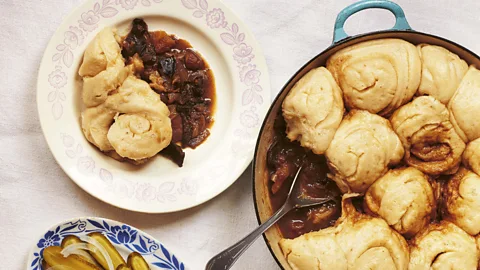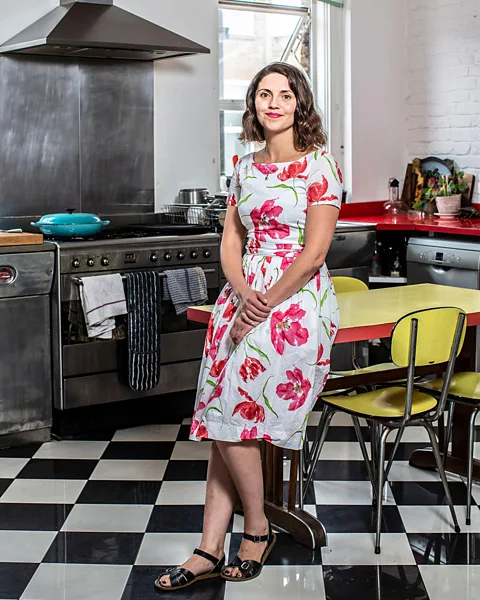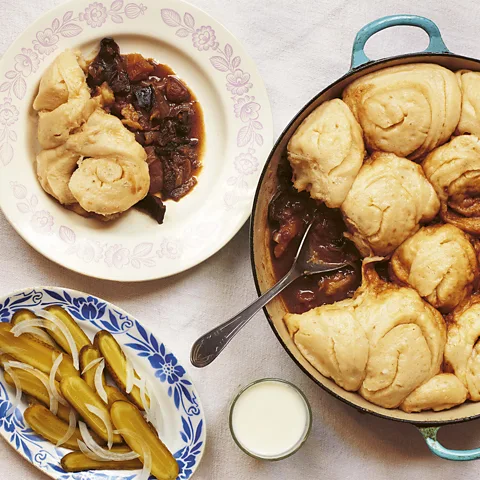Nudli: Ukrainian dumpling stew
 Olia Hercules
Olia HerculesAward-winning cookbook author Olia Hercules offers a vegetarian twist on this celebratory dish, with mushrooms and potatoes in a comforting but light vegetable broth.
Nudli is a celebratory dish, if you ask Olia Hercules – an award-winning Ukrainian cookbook author. Traditionally, it's a hearty, comforting dumpling stew traditionally made with meat, onions and potatoes, perfect for a cold winter's day.
Hercules' take on it is an adaptation of an adaptation that tells a piece of her family's story. Her grandmother would make the dumplings with bicarbonate of soda and serve them with meat, usually slow-cooked duck or pork ribs. But her husband is a vegetarian, so Hercules' mother swapped the meat for mushrooms. Then Hercules herself ditched the bicarbonate of soda for a yeasted dough to make the dumplings. This, she said, creates a lighter dough that's easier for first-timers to make and more enjoyable to eat throughout the year.
"I feel like it's light enough to have it during a warm season," she said. "The mushroom [version] is quite light as well. Just serve it with a nice salad and it's super satisfying."
Hercules is from Kakhovka, a port city just outside Kherson and only 74km north of Crimea. She spent the first 12 years of her life living through the end of Soviet Ukraine and its early years as an independent nation before moving to Cyprus. At 18, she relocated to the United Kingdom to study and work as a journalist for a film publication until the financial crisis of 2008 and 2009 opened up a new opportunity for her.
"I decided to take the plunge, leave my job and retrain to be a chef," she said. "I worked in restaurants, worked as a caterer and did any kind of job that I could do."
That led right into her first cookbook, Mamushka: Recipes from Ukraine & beyond in 2015, which won Hercules the Observer's Rising Star Award. And rise, she did, publishing Kaukasis The Cookbook: The culinary journey through Georgia, Azerbaijan & beyond in 2017 and Summer Kitchens: Recipes and Reminiscences from Every Corner of Ukraine in 2020. Most recently, she published Home Food: Recipes to Comfort and Connect.
Home Food came out just months after Russia's invasion of Ukraine on 24 February 2022. Suddenly, Ukrainian culture and cuisine were thrust into the spotlight. The Times listed Home Food as one of their Best Food Books of 2022 and The Independent crowned it the Best Cookbook of the Year.
The praise was all a bit of a surprise to Hercules.
"Writing a cookbook was an unachievable dream," she said. "I didn't even dare to dream it."
Hercules' first book, Mamushka, came out not long after the Russian annexation of Crimea. The news prompted a kind of curiosity about this European nation that Hercules says many knew nothing about. That interest only intensified with the escalation of the conflict in 2022.
"I think the war also made a difference and made people interested in [Ukrainian cuisine]," she said. "And there I was with my Ukrainian cooking, ready to go."
Prior to the war, Hercules would visit Ukraine at least twice a year to see family and friends. That would increase to once every three months or so during research trips for book projects. The war changed that, but it's obvious Hercules' heart is still there.
 Jeff Gilbert/Alamy
Jeff Gilbert/AlamyAlong with her food writer friend, Alissa Timoshkina, and a team of supporters, Hercules has been encouraging people to cook Ukrainian food and donate to the fundraising drive that aids children and families in Ukraine who have been displaced by the war.
Hercules said that encouraging others to cook Ukrainian food helps people relate to Ukrainians and not forget them because of war fatigue – that is, the constant stream of negative headlines coming out of the country. Her approach is a softer one, she said, that helps humanise Ukrainians.
With her nudli recipe, Hercules offers home cooks a highly regional look at the cuisine.
This is a dish that's better known in Hercules' corner of southern Ukraine, stretching to the Romanian and Moldovan borders outside of Odesa. And it's one that's been passed down for generations.
"It's a celebratory kind of dish," she said. "It's one of those dishes that we cook when the whole family gets together."
Hercules' family would make it for family reunions when she was a child. The tradition faded away after her grandmother passed away, but Hercules picked up the torch 10 years ago.
"We started getting together every August," she said. "Even though it's a bit of a wintry kind of dish, we still make it in August. We just have loads of fresh salads instead of pickles on the side."
 Olia Hercules
Olia Hercules(serves 4-6)
Ingredients
For the dough
200ml kefir (or 150ml yoghurt thinned with 50ml water)
15g fresh yeast, or 7g fast action dried yeast
1 tbsp brown sugar
1 egg, lightly beaten
1 tsp salt
450g plain flour (or 350g plain flour plus 100g wholemeal or spelt flour), plus more to dust
vegetable oil
50g clarified butter or regular unsalted butter, melted
For the stew
500ml hot vegetable stock, or hot water
50g dried mushrooms
4 tbsp vegetable oil
knob of unsalted butter
2 onions, thickly sliced
salt
400g chestnut mushrooms
500g potatoes, scrubbed but unpeeled, cut in wedges
2 large garlic cloves, roughly chopped
black or white pepper
Method
Step 1
Mix the kefir with the yeast and brown sugar in a large bowl and whisk well. Wait a little bit until yeasty froth appears to make sure the yeast is alive. Then add the egg and 1 tsp salt and give it all a good whisk. Add 400g of the flour and mix it first with a spoon. Then put your hand in. The dough might be very wet, so stretch it out and then slap the dough against the sides of the bowl for as long as your patience and muscle power allow you. If you feel like the dough is way too wet, add the extra 50g of flour (but keep in mind: the wetter the dough, the lighter the dumplings).
Step 2
Wet your hands, fold the dough into a rough ball and put into a large oiled bowl to rise (I just use the bowl I mixed everything in to save on washing-up). Cover tightly with clingfilm or a tea towel and leave somewhere warm to rise. It should double in size, and, depending on the temperature in your kitchen, can take up to 1–2 hours. Or you can leave it in the fridge overnight.
Step 3
Have 1–2 large and lightly oiled trays at the ready, to place your dumplings on for proving after you have cut them. When the dough is proudly puffed up, flour a work surface well and gently help the dough out of the bowl. It will be very soft and will deflate as it hits the surface. Gently give it a knead. Enjoy this brief process and be tender.
Step 4
Making sure the surface really is well floured, so the dough doesn't stick, roll it into a 30cm sheet. Now drizzle the clarified or regular butter all over it, and, using the palm of your hand, spread it all over the dough. Roll it all up into a sausage shape, evening it up along its length if needed, and cut across into 16-18 pieces. They will look similar to cinnamon rolls. Put them snail side up and a few centimetres apart from each other on the oiled trays and loosely cover with tea towels. (Be careful with the choice of towels, as they can get stuck to the tops if the dough is quite moist; linen is a good option.) Leave to prove for 30 minutes.
Step 5
Meanwhile, for the stew, pour the hot stock or water over the dried mushrooms in a bowl and soak them for at least 30 minutes.
Step 6
Take the mushrooms out of their soaking liquid and put them into another bowl. Then strain the liquid into the bowl with the mushrooms through muslin, to make sure no grit passes through.
Step 6
Heat 1 tbsp of the oil and the knob of butter in a large pan for which you have a tight-fitting lid. Add the onions and a generous pinch of salt and cook over a medium-low heat for about 15 minutes. If the onions start catching, just add a splash of the mushroom liquid to deglaze the base of the pan. Cook the onions for as long as you have the patience or time: another 15 minutes on a low flame is great, but if the onions look softened and have taken a little bit of colour, it will be good enough.
Step 7
Take the onions out and put them into a bowl. Quarter or halve the chestnut mushrooms, depending on size. Add another 1 tbsp of oil to the pan along with the mushrooms and a pinch of salt. Fry over medium-high heat until they are brown all over, then add them to the onions.
Step 8
Heat another 1 tbsp of oil in the pan and add the potatoes. Cook them on each side until lightly browned. Now return the mushrooms and onions to the pan, add the garlic and cook for a minute or so. Pour in the mushroom stock, the rehydrated mushrooms, another pinch of salt and a healthy grind of black or white pepper and give it a gentle stir. Cook for about 10 minutes over a medium heat.
Step 9
Now, be ready! Have your stew bubbling away over a medium-high heat. If your dumplings feel quite soft and a little sticky, use an oiled spatula or dough scraper to scoop them off the tray; otherwise, pick them up with your hand. Add the dumplings pretty/curled side up on top; they will puff up, so leave at least 1cm between each. Cover with a lid immediately after putting the last dumpling in. Cook over a medium-high heat for 20 minutes. The dumplings will puff up and be soaked with delicious stew juices at the bottom and fluffy on top.
Step 10
I cannot describe the satisfaction this dish brings. Serve it with a bright winter slaw or some pickles or salad on the side. It is also good with a glass of kefir. It is best eaten on the same day, but we love to scoff it cold the next day if some is miraculously left over. It is also light enough to be eaten on a rainy summer's day.
BBC.com's World's Table "smashes the kitchen ceiling" by changing the way the world thinks about food, through the past, present and future.
---
Join more than three million BBC Travel fans by liking us on Facebook, or follow us on Twitter and Instagram.
If you liked this story, sign up for the weekly bbc.com features newsletter called "The Essential List". A handpicked selection of stories from BBC Future, Culture, Worklife and Travel, delivered to your inbox every Friday.
